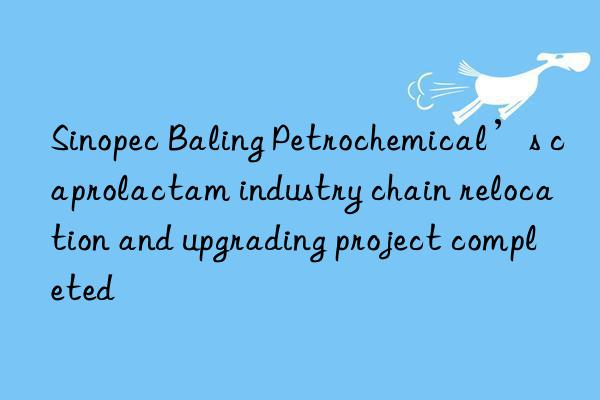
On December 15, the "dual key" engineering projects of Sinopec and Hunan Province to deepen strategic cooperation and the relocation, upgrading and transformation development project of Baling Petrochemical Company's annual production of 600,000 tons of caprolactam industry chain were successfully completed. Achieve a successful drive. This marks the completion and commissioning of the caprolactam production R&D base with the world's largest single set of production capacity and leading technology. Sinopec's new generation of caprolactam green complete set of new technologies with independent intellectual property rights and industry-leading has been industrialized for the first time.
As Sinopec's first large-scale chemical relocation and upgrading project along the Yangtze River, the project is to implement the important instructions of General Secretary Xi Jinping to "work together to protect the river and not engage in large-scale development" and "protect the clear water of the river", and to solve the problem of "chemical encirclement of the river" and "chemical industry "Besieged city" problem, a demonstration project to promote the green and safe development of the Yangtze River Economic Belt, has been listed by the Ministry of Industry and Information Technology as a demonstration project and benchmark project for the relocation of hazardous chemical production enterprises in densely populated urban areas.
The project, with a total investment of 15.35 billion yuan, will relocate the caprolactam industry chain of Baling Petrochemical, which is less than 1 kilometer away from the Yangtze River and connected with the main urban area of Yueyang City, to the Yueyang Green Chemical High-tech Zone in Hunan, 3.1 kilometers away from the Yangtze River coastline, covering an area of 2650 acres. In accordance with the idea of "safety and green, technology upgrade, construction first, demolition later, and doubling the scale", new coal gasification, caprolactam, polyamide, synthetic ammonia, hydrogen peroxide, cyclohexanone, ammoximation, sulfur acid production, ammonium sulfate and public engineering equipment58 Set, covering the entire industrial chain from coal-based hydrogen production to polyamide, the annual caprolactam production capacity has been increased from 300,000 tons to 600,000 tons.
The project is constructed using the caprolactam green complete new technology that won the China Industrial Award and the First Prize of the National Technology Invention Award. Among them, esterification and hydrogenation to produce cyclohexanone and slurry bed anthraquinone to produce hydrogen peroxide are Sinopec's "Ten Dragon" scientific and technological projects. The esterification and hydrogenation to cyclohexanone device is the world's first industrialized device. It adopts a new reaction principle and subverts the tradition. The process technology route has the advantages of high carbon yield, low "three wastes" emissions, clean and efficient, and provides important technical support for the transformation and development of the industrial chain; slurry bed anthraquinone production of hydrogen peroxide technology, cyclohexanone oxime production of cyclohexanone oxime The technology has been successfully scaled up and applied for the first time, and the safety factor of the new hydrogen peroxide technology has been effectively improved; the coal gasification device is Sinopec’s first device using the third-generation domestic coal-water slurry water-cooled wall gasification technology. The project is constructed in accordance with the "5G smart factory" standards, with a localization rate of 99.9% of the equipment and all central control systems.
The project started construction in June 2021 and was fully handed over in July this year. Since August, on the basis of the early start-up operation of public engineering equipment, polyamide, caprolactam and other process equipment have been successfully started up one after another, and high-quality products have been exported and shipped. The project reintegrates scattered devices and greatly increases the degree of intensification. While the production capacity is doubled and the floor area is reduced by one-third, the total water consumption is reduced by 70%. The unit product discharges wastewater, COD (chemical oxygen demand), Comprehensive energy consumption was reduced by 73%, 67%, and 20% respectively, staffing was streamlined by 60%, and labor productivity, product quality, and comprehensive competitiveness were significantly enhanced.
The project adopts the "E+P+C" (Engineering + Procurement + Construction) construction model under the leadership of IPMT (Integrated Project Management). All parties involved in the construction focused on the "six major control" objectives of safety, quality, progress, investment, contracts, and integrity, adhered to the leadership of party building and the integration and mutual promotion of project construction, and adhered to the principle of "one family, one heart, one goal, one effort", and the data Thousands of builders overcame the adverse effects of the COVID-19 epidemic and extreme weather, gave full play to Sinopec's "large corps" combat advantages, and made every effort to promote the safe and high-quality completion of the project and put it into operation.
As an important organic chemical raw material, caprolactam is widely used in degradable films, medical devices, high-end clothing, automobile wheels and other fields. While implementing the relocation and upgrading of the caprolactam industry chain, Baling Petrochemical is focusing on the development of downstream polyamide business, taking the lead in Sinopec's 2023 major research project "Key Technology Development and Industrial Demonstration of High-End Polyamide Materials" to promote chemical raw materials to new chemical materials Upgrading and transformation will drive the development of downstream industry clusters worth hundreds of billions. This project promotes the transformation and upgrading of the traditional petrochemical industry to high-end, intelligent, green and integrated through industrial chain upgrading, product chain extension and value chain improvement, and provides a new path and new model for the green transformation and development of the heavy chemical industry along the river.

 微信扫一扫打赏
微信扫一扫打赏

